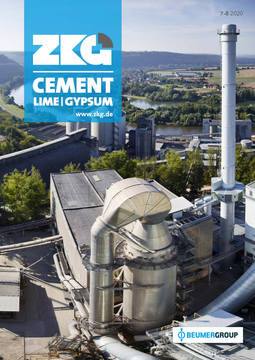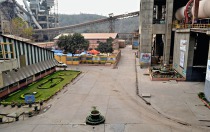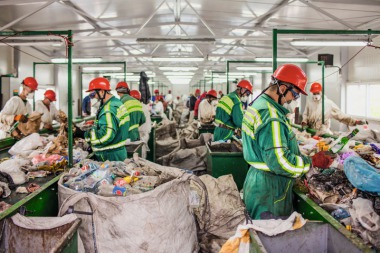Thermal recycling in India is increasing – with certain difficulties
More and more, cement plants in India are now using alternative fuels and raw materials. The government is promoting this development: Through the central and state environmental protection authorities (CPCB and SPCB), it has developed initiatives to increase the use of alternative fuels and raw materials in the cement industry.
India is the second largest cement producer in the world. The cement industry in the South Asian country offers jobs to more than a million people directly or indirectly. Since the liberalization of India’s economy in 1982, the industry has attracted huge investments from both Indian and foreign investors. The basis for this development is the country’s great potential: the infrastructure, a bottleneck of the entire Indian economy, is being expanded, particularly with government support. The construction sector is booming in the face of a rapidly growing middle class. The cement sector should benefit greatly from this.
Growth in alternatives energies
According to the Cement Sustainability Initiative of the World Business Council for Sustainable Development, the alternative energy consumption in the industry rose from 0.6 % in 2010 to 3.7 % in 2015. Although it dropped to 2.7 % in 2017, especially because of higher prices, it is expected that this trend will reverse in the coming years due to the improved economy.
Regulatory factors have accelerated the joint processing of waste by cement companies. The Ministry for the Environment, Forests and Climate Change (MoEFCC) issued its rules for waste management in 2016. These give preference to the co-processing of waste as a management option. Central government agencies in New Delhi have also approved the transportation of hazardous waste between states to encourage co-processing.
Indian cement plants use different types of waste as alternative fuels. Solid waste accounts for 73 % of the total use of alternative fuels. Major types of solid waste used are carbon black, tire chips and bed ash. There is currently considerable potential for increasing the use of alternative fuels from municipal waste.
Approximately 80 % of the estimated 62 million tons of municipal waste produced in India are disposed of indiscriminately at landfills. In one scenario, India will need 8800 hectares of landfill by 2050, which is the size of the city of New Delhi. By using 25 percent of alternative fuels and raw materials by 2050 (in accordance with the goals of the Roadmap of the International Energy Agency (IEA) for low carbon technology roadmap (LCTR)), the cement industry can contribute to increase the space requirements for landfill by 26 %.
The new rules for the disposal of solid waste (SWM) 2016 of the MoEFCC replace the municipal rules for the disposal of solid waste (management and handling) of 2000. One of the most important components of the new rules is the promotion of energy production in cement plants using co-processing systems. The regulations mandate that all industrial plants that use fuels and are within 100 kilometers of a solid fuel substitute plant must make arrangements within six months from the date of notification of these rules to replace at least 5% of their fuel requirement by refuse derived fuels.
The rules also direct that non-recyclable wastes having a calorific value of 1500 kcal/kg or more need to be used to generate energy at waste-to-energy plants or giving it away as feed stock for the preparation of refuse-derived fuel for cement kilns. High-calorific wastes shall be used for co-processing in cement or thermal power plants.
For Indian cement plants to increase the use of alternative fuel by 25 % (in 2050) is a major barrier because of the high costs of material sourcing and acquisition. Experts demand that the cost of sourcing the material should be regulated by applying the polluter pays principle. In addition, higher fuel substitution should take place if waste legislation restricts landfilling and dedicated incineration and allows controlled collection and treatment of alternative fuels.
The main technical barrier is the adverse impact created on kiln production and specific energy consumption. The government could counteract this by providing incentives for the use of fuels derived from municipal solid waste and biomass.
Nonetheless, the industry is shifting rapidly in the country. More than 60 cement plants in India recently reported the continuous use of alternative fuels. Numerous cement plants have built facilities for co-processing. In the past few months, seven plants have set up pre-treatment plants to convert non-homogeneous waste into alternative fuels with the desired quality parameters - the total investment is more than € 30 million.
Geocycle is serving the two LafargHolcim brands ACC Limited and Ambuja Cement in India. “Single kilns or plants have reached TSR of 20-30 %, but the industry average is around 4 %”, says Berthold Kren, Region Head of Geocycle Asia and Head of Geocycle India. “Our average is around 6-7 %.”
LafargeHolcim acquired ACC Ltd and Ambuja Cement in 2005. “The first steps in implementing an organisation for dealing with the utilization of waste in cement kilns started shortly after”, says Kren. “Geocycle as a brand started in 2009 to introduce co-processing and worked with authorities to obtain permits. Since there is no or only very little infrastructure in waste management in general, preprocessing capacities had and have to be built by ourselves. Industrial players in producing RDF are developing very slowly, because gate fees are too low. Dumping and landfilling are too cheap to create room for other alternatives, despite being a major problem in growing megacities like Mumbai, Delhi etc.”
Co-processing is the more economical and ecological solution (no ash to landfill, no additional emissions etc) but in India there are three major challenges, says Kren: “One key problem is the huge distance between the cities and the cement plants. This leads above all to high costs.” Secondly, the quality of the waste is very different from what is known in Europe. 50 % organic content and high moisture, result in low calorific value and make the utilization of municipal waste very difficult in cement kilns. Thirdly, there is also a lack of knowledge and understanding of the technology. “This leads to long lead times for approval.”
There are practical examples of dynamic development from various parts of the country. Waste-processing company Green Worms has won a contract for landfill extraction, refuse-derived fuel (RDF) processing and transportation to cement plants from the town authority of Fort Kochi in the southern Indian state of Kerala. The New Indian Express newspaper has reported that recyclable material will be removed before the waste is processed into fuel. “89 % of waste is recyclable. But the rest can be converted into RDF”, says Green Worms project manager Thajudeen Abubacker.
Also in Kerala, Dhandapani Cements signed a Memorandum of Understanding with Tiruchi City Corporation to process inert waste from the city. The cement maker had agreed to collect 1000 tons of inert waste a year, including plastic waste, fabrics, tires, and other materials, according to The Hindu newspaper. The deal will last five years.
In the East Indian state of Andhra Pradesh, Vijayawada Municipal Corporation (VMC) has meanwhile started to transport alternative fuels from its recycling plant in Ajit Singh Nagar to UltraTech‘s Balaji cement plant. According to an agreement between the city and the cement manufacturer, the plant consumes 50 tons of RDF per day, according to the New Indian Express newspaper. The city council sorts the dry waste into alternative fuels, the cement company takes care of the transport.
In the far north-east of the country, in Meghalaya, Dalmia Cement and Topcem have signed an agreement with the state government to buy plastic waste from cleanup operations at a price of US$ 422 per ton. The companies, whose combined integrated cement capacity in the state is 2.5 million t/year, will burn the alternative fuel as a partial replacement for coal in three plants. The initiative has more than just an economic background: the News18 portal reported that the deal is part of a concerted campaign by the government, NGOs, and the public to be on time for the National Games (formerly the Olympic Games in India) that the state will host in 2022 to create a cleaner and plastic free Meghalaya.






